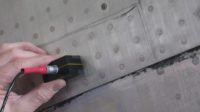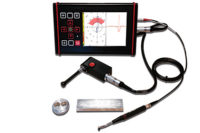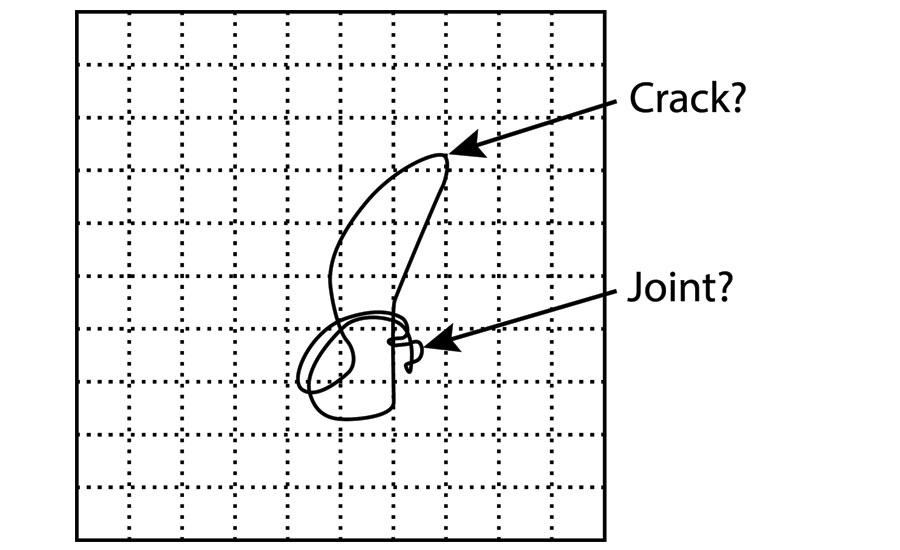Using Eddy Current Array in Detecting Cracks and Corrosion in Aircraft Longerons
Results in the field have demonstrated that ECA probes can replace a number of conventional NDT inspection methods.












Aircraft are the backbone of several industries and, as such, are subjected to intense and near-continuous use, making preventive maintenance critical. Maintenance protocols are exhaustive, but time-consuming, especially when fuselage and wing longerons are involved. Several multilayered aluminum structures make up aircraft structures; this article focuses on longerons and their fasteners.
LONGERON FASTENERS AND FAYING SURFACES
Longerons usually carry larger aircraft loads and help transfer skin loads to the internal aircraft structure. Longerons nearly always attach to frames, ribs, or directly to the skin of the aircraft, creating a multilayer aluminum structure. Fatigue and stress cracking eventually appear around the fasteners used to secure the longerons to these structures. Such cracks risk going undetected because they are small (typically 1.25 mm / 0.05 in), they are near / under fastener heads, and often under surface coatings.
Another problem that must be detected and monitored is the corrosion at the faying surface between longerons and the aluminum skin to which they are attached. Faying surfaces are the contact surfaces of two materials placed in tight contact to form a joint. They are used in engineering fastening and joint development of different members to form a strong structure. Faying surfaces usually have a sealant between them so that there is no remaining gap. To prevent corrosion at the faying surface, primers or sealing agents are used to provide an airtight or moisture-tight joint.
If left unchecked, corrosion at the faying surface creates pitting and produces aluminum oxide and hydroxide that are much more voluminous than the initial aluminum alloy. This higher volume results in out-of-plane deformation of the skin between the fasteners referred to as pillowing, which is highly undesirable and must be caught before it develops.
TYPICAL INSPECTION METHODS OF LONGERONS
The following methods are typically used to inspect longerons:
- Liquid penetrant testing (PT): Used to detect surface-breaking cracks and, occasionally, surface pitting from corrosion.
- Eddy current testing (ECT): Used to detect cracks and material thinning from corrosion.
- Ultrasonic testing (UT): Such methods as the pulse-echo technique are used for in-service inspection of aircraft parts.
EDDY CURRENT ARRAY
Advances in electromagnetic testing has seen the advent of eddy current array (ECA) probes, test instruments, and software powerful enough to process the high number of multiplexed channels.
ECA probes use several individual coils, grouped together in one probe. The coils are excited sequentially to eliminate interference from mutual inductance (a process referred to as channel multiplexing). This enables single-pass scans—a major improvement over operator-dependent ECT raster scans. Data from ECA probes can be encoded and is transmitted directly to software for graphical display (C-scan), record keeping, and reporting.
Results in the field have demonstrated that ECA probes can replace a number of conventional NDT inspection methods, such as magnetic particle testing (MT), PT, and ECT, by significantly reducing inspection times, offering improved flaw detection, and allowing for full inspection records.
As mentioned above, potential cracks in the vicinity of longeron fasteners are typically short. They also radiate in all directions and they do not break the surface, making them difficult to detect. Hidden corrosion at the faying surface of multilayered aluminum structures is also hard to locate, the required corrosion detection threshold being typically 10% in material loss in such structures. Historically, inspecting these multilayered aluminum structures for cracks and subsurface corrosion required two different instruments, two different types of probes, and sometimes even different software.
An ECA probe that could detect both types of defects within their respective tolerances was therefore developed. This probe incorporates two arrays of coils that use a proprietary coil topology (coil arrangement + channel multiplexing pattern). The first array has a high resolution and uses small, high-frequency coils to detect the cracks around fasteners. The second array is designed to detect subsurface corrosion. The semi-flexible mechanical design of the probe also makes it capable of conforming to the curves in the structure under test. The software interface configuring the probe for inspection is used to switch between crack and corrosion inspections on the fly, without switching probes.
This all-in-one probe design allows detecting corrosion build-ups ±5% of the layer thickness (e.g., down to 0.5 mm of a 10 mm layer), which is approximately twice as good as the initial requirement and the capabilities of typical inspection methods. The probe is also able to detect 1.25 mm (0.05 in) longitudinal, transverse, and oblique stress cracks along the load path of longerons.
BENEFITS OF ECA
This advancement in ECA technology brings several benefits to the industry:
- Improved planning — By easily identifying cracks and corrosion between skin and longeron, it is easier to plan long-term maintenance.
- Faster execution — Switching from the crack inspection setup to the corrosion inspection setup is very quick. No need for a new hardware setup and the ECA probe offers wider coverage than other inspection technologies, hence the task of inspecting for these defects has gone from hours to minutes.
- Wider coverage — Single-pass scanning is faster and yields more dependable information for trending analysis, for example.
- Better detection capabilities — ECA offers a higher probability of detection of target defects than conventional inspection methods.
- Better use of qualified personnel — Spending less time switching between inspection setups, qualified personnel can perform more inspections.
- Easier analysis because of simpler scan patterns.
- Improved positioning and sizing because of encoded data.
- Data archiving — Having access to archived inspection data allows for advanced trending analysis to, for example, monitor crack / corrosion growth and extrapolate their behavior.
Furthermore, array probes can easily be designed to be flexible or shaped to specifications, making hard-to-reach areas easier to inspect.
In conclusion, refinements in ECA technology are revealing advanced electromagnetic testing as an NDT technique that can reliably supplement and even replace conventional ones not only in multilayered aluminum structure inspection, but in an assortment of other applications across several industries.
Looking for a reprint of this article?
From high-res PDFs to custom plaques, order your copy today!











